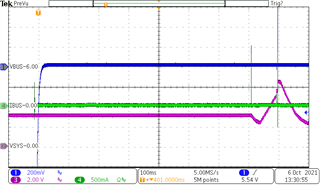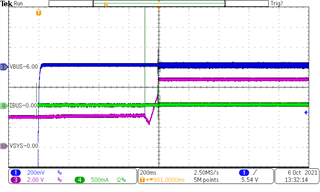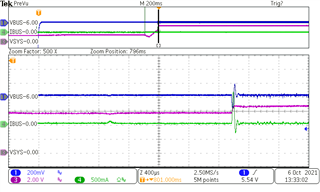Other Parts Discussed in Thread: BQ25883, BQ25883EVM
I am using the BQ25886 to charge two batteries in series. I am using an external safety circuit to cut off the batteries in an over-discharge condition.
My system power supply is near the upper limit of 6.2V. Everything works fine until the batteries are over-discharged. When this happens, the safety
circuit opens the ground contact on the lower battery as expected. When the system is powered once again, the V_SYS starts to come up, but then
shuts down again along with REGN and the the BATFET never closes. The STAT pin oscillates at 1Hz. Once it has attempted to come up once it never
makes another attempt. Since the battery protection circuit never got any voltage through VBAT, it remains tripped and the battery never reconnects.
If I lower the VBUS voltage below 6V or so then everything works as expected. My system power supplies range up to 6.1V so simply lowering
the VBUS is not an easy fix. I am not sure what is causing the fault. It doesn't appear to be a VBUS_OVP fault since
V_SYS starts to come up, and the V_BUS is stable below 6.2V. It could be a perceived VBUS short since VBUS and V_SYS are about the same voltage
when the battery is not present. What might be causing the V_SYS fault and preventing VBAT from powering? Is there a way around this issue?
The input power is set as a DCP and the charge limit is set at 500mA with a charge voltage of 8.2V.
Steve






